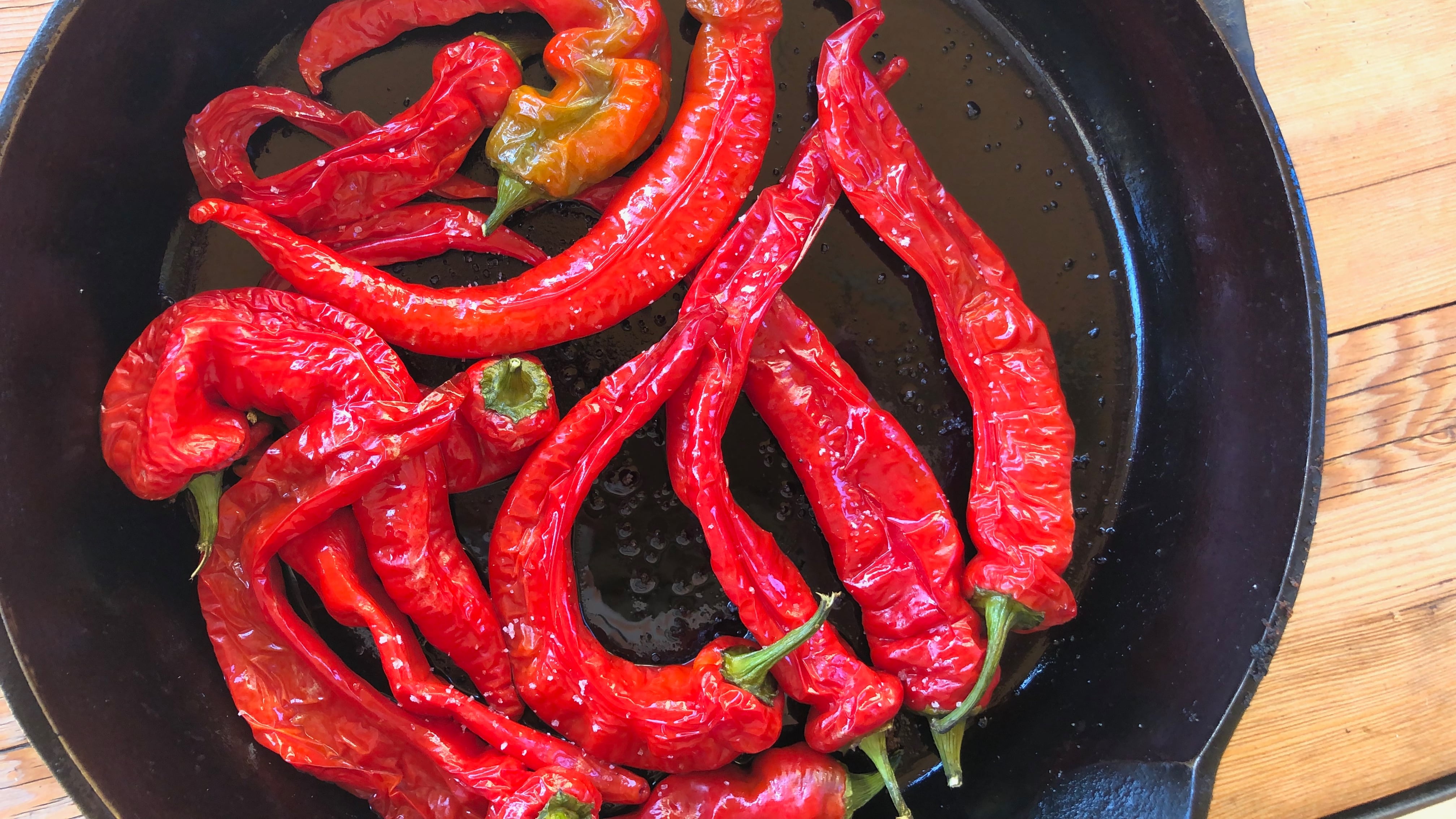Jim Dixon wrote about food for WW for more than 20 years, but these days most of his time is spent at his olive oil-focused specialty food business Wellspent Market. Jim’s always loved to eat, and he encourages his customers to cook by sending them recipes every week through his newsletter. We’re happy to have him back creating some special dishes just for WW readers.
Your first taste of a Jimmy Nardello changes everything you thought you knew about peppers. Sure, you already understood that jalapeños are hot and bell peppers are not, but you didn’t know there was a pepper as sweet as candy. And since humans are hardwired to like things that are sweet, once you taste a Jimmy you want more.
Fortunately, more farmers grow the long, skinny, bright red Capsicum annuum, known in America as Jimmy Nardellos, so they’re easier to find these days. But they’re a seasonal treat, so don’t wait to hit the farmers markets or better produce departments. When you find some, buy a lot, because you’ll want to eat as many as you can while they’re around.
The story of Jimmy Nardellos is as good as the pepper itself. Giuseppe and Angela Nardiello, Jimmy’s parents, left their southern Italian village of Ruoti in 1887 to make a new life in America. They eventually landed in Naugatuck, Conn., where Guiseppe might’ve worked at the Goodyear Metallic Rubber Shoe Company or possibly the branch of Hershey that made Mounds and Almond Joy candy bars. Angela planted a huge garden, raised 11 children, and passed her love of growing food to son No. 4 Jimmy, whose grade school teachers dropped that troublesome “i” from his last name. He stayed in Naugatuck his whole life and grew his favorite peppers, the sweet red frying peppers that, after he donated seeds to the Seed Savers Exchange, came to bear his name.
We don’t know if Jimmy kept the seeds from the sweetest of peppers for the next year’s crop, but it seems likely that the intense sweetness came from some form of selective breeding. Almost all of the members of the Capsicum family produce capsaicin, the chemical compound responsible for the burning heat and the plant’s way of preventing insects and mammals from eating its fruit (it doesn’t affect birds, so they can spread the seeds). The handful of cultivars with no capsaicin, like bell peppers, cubanelles, and Jimmy Nardellos, have a recessive gene that eliminates the spicy compound.
Jimmy’s favorite peppers are likely the same cultivar as peperone di Senise, a variety of what are called “Italian frying peppers” grown around the town of Sinese in the province of Basilicata, the instep of the boot-shaped peninsula. They’re called “crusco” locally, a dialect word that means “crunchy,” and the peppers are dried in the sun before frying to become peperone cruschi, a crispy, chip-like snack. Apparently Jimmy made peperone cruschi from his peppers, something I’ve tried repeatedly, but never got them to taste like the ones I ate in Matera, another town in Basilicata’s cruschi belt (I asked for some just over the provincial border in Calabria and they’d never heard of them).
These peppers taste really, really good fresh, and that’s how I like to eat them. While you can pan fry them in a little olive oil like any of the Italian frying peppers, the often twisty shapes of Jimmy Nardellos makes it hard to get the pan-to-pepper contact you need, and they don’t get cooked evenly. It’s much easier to toss them with a little olive oil and pop them in the oven. Once they’ve softened and are lightly browned, sprinkle on some flaky salt, pick them up by the stem and eat. After that first bite you’ll wish you’d bought more; it’s not hard to eat the whole skillet yourself.
Roasted Jimmy Nardello Peppers
8-10 Jimmy Nardello peppers*
Extra-virgin olive oil
Kosher-style or other flaky salt
*The peppers vary in size and shape, but 8-10 or about 3/4 pound is about how many I can get in a 10-inch skillet.
Put the peppers in a heavy skillet; it’s fine if they overlap a little. Drizzle with a little olive oil and toss with your hands.
Roast at 350 degrees for 25-30 minutes, or until the peppers are soft and the skins have just started to brown. Remove from the oven and sprinkle with flaky salt. Let cool a little, then eat warm or at room temperature.

